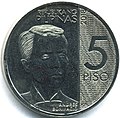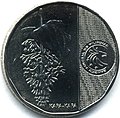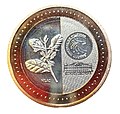2007–2019: New Generation Currency Project and Demonetization of New Design Series
In 2007, Bangko Sentral ng Pilipinas (BSP) began the 12-year demonetization process of the New Design Series when the New Generation Currency (NGC) project was started the formal conceptualization process, which was a meeting of the minds of people with diverse backgrounds and ideas: central bankers, artists, technocrats, historians, communication experts, and currency printers to further enhance security features and to improve durability. The thematic content, designs, and security features underwent thorough deliberations and evaluation, and was undertaken by the BSP’s Numismatic Committee (Num Com) in consultation with the Monetary Board (MB) and, subsequently, with the approval of the BSP Governor and the President of the Philippines. [2] [3]
The members of the numismatic committee included Bangko Sentral Deputy Governor Diwa Guinigundo and Dr. Ambeth Ocampo, chairman of the National Historical Institute. Designed by Studio 5 Designs and Design Systemat, the new banknotes' designs features famous Filipinos and iconic natural wonders. Philippine national symbols will be depicted on coins. The series' initial batch started printing on November 2010 and released it to the general public on December 16, 2010, three years after the project and process for NDS demonetization were started. The word used in the bills was "Pilipino" rendered in Baybayin (ᜉᜒᜎᜒᜉᜒᜈᜓ). The font used for lettering in the banknotes is Myriad, while the numerals are set in the Twentieth Century font. It was approved by Presidents Gloria Macapagal Arroyo and her immediate successor Benigno Aquino III, making the only banknote series to be approved by two presidents. [4] [5]
In December 2016, BSP announced that they will launch sets of banknotes bearing President Rodrigo Duterte's signature. The BSP initially released five million pieces of the new 20, 50, 100, 500, and 1,000-peso bills with Duterte's signature. As for the 200-pesos bills, only two million pieces were released because of lower demand for this denomination. [6]
In 2017, Bangko Sentral ng Pilipinas updated the design of the P200 and P1000 NGC series banknotes. Also on that same year, BSP introduced the New Generation Currency Coin Series which was circulated through banks. The new series features native Philippine flora. Sentimo denominated coins feature a stylized representation of the Philippine flag on the obverse. Peso denominated coins depict the portraits of renowned national heroes of the Philippines on the obverse. The coins are struck in Nickel-plated steel for all six denominations, in response to the widespread hoarding and melting down of the coins, decreasing the cost of production of minting the coins and address concerns of the discoloration of the coins due to the humid, tropical environment. The 10-sentimo coin is not included in this series, because it was removed as a general circulation coin. [7] [8]
In July 2019, the BSP announced plans to replace the ₱20 bill with a ₱20 coin by the 1st quarter of 2020. [9] However, ₱20 bills are still printed in 2020, [10] alongside the enhanced version of the other denominations.
The New Generation Currency series were the only circulating set of notes since August 2, 2019 upon the demonetization of 2,000 and 100,000 peso commemorative banknotes, which completed the 12-year NGC project and demonetization process of NDS/BSP series banknotes. [11] [12]
2019–present: Post-NGC project changes and additions
In September 2019, Benjamin Diokno, the current BSP governor, announced that the ₱5 coin, being confused for the ₱1 coin, will have a revised design, featuring a wave edge or scallop shape and enhanced security features. The ₱20 coin received its final designs in the same month and the two coins will be released for circulation in December 2019. The 5-piso coin will have a nonagonal shape. The 20-piso coin will be bimetallic. The 20-piso coin will be the second bimetallic coin in circulation after the 10-piso coin of the New Design/BSP series. In July 2020, the BSP released an improved version of the NGC series. In addition to the security features currently present for five denominations (excluding the P20 banknote), the new banknotes will have an updated security thread and design for all five denominations. The notes also have features for the benefit of the visually impaired. [13] [14] [15]
In 2021, the BSP announced that it will test run the issuance of polymer banknotes through a limited issuance of 1,000-peso bills during the first half of 2022, as part of a long-term study to move to polymer notes. [16] The banknotes will be printed by Note Printing Australia (NPA), wholly owned subsidiary of the Reserve Bank of Australia (RBA) as result of a government-to-government (G2G) memorandum of understanding between the RBA and the BSP. [17]
In 2021, BSP silently approved the end of production of the 200-peso banknote due to low usage. [18] [19]
In December 2022, BSP announced the new banknotes bearing the signatures of President Bongbong Marcos and BSP Governor Felipe Medalla. The 2020 BSP logo is now also used on 20, 50, 100, 500, and 1,000-piso (non-polymer version) bills which replaced the 2010 logo that has been in use since March 2010 upon the announcement of the series' imminent start of print run and resulting release to the public from November to December 2010 where its early design closer to the final was previewed. [20] [21] [22]












